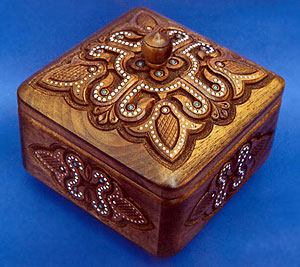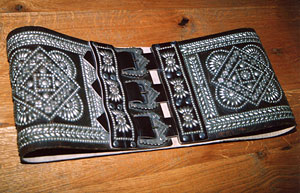- About Ukraine
- The Name of the State
- Geographic Situation
- The Land
- Natural Resources
- The Seas and Inland Waters
- The Climate
- The Flora
- The Fauna
- Administrative and Territorial Organization
- The Population
- Kyiv
- Folk art from Ukraine
- Love Ukraine
- Ivano-Frankivsk region
- Hutsuliya
- Rest and Tourism
- Photograph Album
- Library
- Feed
- Store
Ukrainian folk art has centuries-old traditions. Ukrainian weavers, painters, wood-carvers, potters, carpet-makers and embroideresses are well-known all over the Soviet Union and abroad. Folk art in Ukraine is rich in forms and design and varies from region to region. In Ukraine there are a number of districts where folk arts and handicrafts have a distinctly local character. The works of the craftsmen of the Dnieper Basin, of Chernigiv Polissia and of the Hutsul folk masters are quite different, beautiful in their own way and popular.
 Pottery art
Pottery art
Folk art is closely connected with the customs of the people. The endurance of tradition is illustrated by customs and rituals which are still alive though their original meaning may be forgotten. The pisanka Easter egg is still painted and the wedding loaf is still baked, but not everybody knows that they are parts of ancient pagan cults.
There are many permanent forms and motifs, connected with these ancient cults, in Ukrainian folk art. A most common ornamental motif is the sun sign which may be a simple circle, one may come across it in wood-carving, in pisanka (Easter egg), in Hutsul metal-ware, on embroidered towels (rushnyk). The representations of horses and birds are else very popular in Ukrainian traditional folk: arts and handicrafts. The old-tine belief was that the bird served as a symbol of peace and prosperity. The horse symbol was used to protect from the evil eye.
 Wood-carving art
Wood-carving art
Various kinds of artistic wood-carving have been known in Ukrainian wood-lands since ancient times, especially in the foothills of the Carpathians. Here, in many families the working of wood is a craft handed down from generation to generation, the Shkriblyaks and the Korpanyuks from the village of Yavoriv, Ivano-Frankivsk Region are especially well-known. Hundreds of master carvers have participated in the decoration of various modern buildings. Thus, Hutsul wood-carvers decorated several restaurants in Ivano-Frankivsk and Yaremcha.
In Ukraine the art of metal-working reached its high-water mark as early as the tenth-twelfth centuries. But at that time it was located in towns. Only at the end of the eighteenth century the craft spread to the countryside. There appeared many craftsmen in the Left-Bank regions, Podillia and the Eastern Carpathians producing jewellery: rings, earrings, ornamental buttons and dukachi necklets of gold and silver coins. Hutsul folk craftsmen living in the Carpathian foothills continue to use the traditional metal-working techniques that were used in the 18-th century to make such things as knives, forester’s axes, pin and needle cases, tobacco pipes, timber-boxes, chains, buttons, crosses and so on.
 Metal working art
Metal working art
The Ukrainians’ top popular arts and handicrafts have long been embroidery, weaving and making of rugs and carpets. In olden days every peasant woman knew how to embroider and do needlework. In fact she was taught that from childhood. In Ukraine embroidery was used to ornament clothes, table-linen and bed-linen and especially the rushnyk towels. Bach place had its own particular methods for embroidering this or that thing and its own colour scheme.
The rushnik towels were used to decorate the interior of the house, to drape windows and the corner where the holy pictures were hung. They were also used at different rituals. The weaving of rugs and hangings was also a most popular craft in Ukraine. The traditional national kilim was an element of interior decoration in every peasant house. It served as wall hanging and table-cloth; the runner-type was spread over benches, while smaller rugs carpeted seats. The main appeal of the kilim lies in its exciting colour scheme.. Now kilims are mostly made at carpet-raking establishments, trough in many villages in the Carpathians peasant women still weave kilims at home. Kosiv and Kolomiya are famous for their kilims all over Ukraine.
 Weaving art
Weaving art
Nowadays there are changes in the way folk craftsmen are trained. There are special art schools and enterprises in such traditional folk art centres as Kosiv, Yavoriv, Vizhnitsya.
Various expositions and the permanent collections of the Kiev Museum of Folk Decorative Art, the Lviv Museum of Ethnography and Handicrafts, the Kolomiya Museum of Hutsul Art display treasures created by the people in the course of many centuries.
The Ukrainians have long decorated with hand-painted designs and scenes not only furniture, carts and playthings but also the walls of their huts inside and out. In north-eastern part of Lviv there is the Museum of Polk Architecture and Rural Life. Its exposition is arranged so as to show all the ethnographic areas of Ukraine. At the beginning of the 20-th century ethnographic and historical ethnographic districts were formed in the present-day western part of Ukraine: Boiko, Hutsul, Lemko, Podillia, Polissia and Volhynia areas, the Carpathian plain and Pokuttia. Each of these areas is reproduced in a separate section of the museum. In each section there are huts, storehouse, workshops, churches and so on. The collection of the museum includes 112 monuments of folk architecture brought in from the western parts of Ukraine. The work is not over. The complete exposition is supposed to include over 200 exhibits.

